South Australia is situated in the south of the country. Its capital city is Adelaide.
- The history of South Australia
- South Australia by numbers
- State flag and emblems
- South Australia attractions
- South Australia fast facts
- References
A printable PDF of the information on this page is available in the right-hand column.
The history of South Australia
Indigenous history
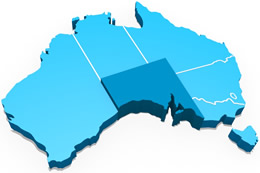
South Australia was home to many Indigenous peoples. For example, the Murray River and the Coorong were home to the Ngarrindjeri and Nganguraku people.
The Kaurna people are the traditional owners of the Adelaide plains in South Australia. Some Kaurna place names still remain today, such as Willunga. Many parks and squares throughout Adelaide are dual named using the Kaurna Warra language. For example, Victoria Square in Adelaide’s CBD is also known by its Kaurna name, Tarntanyangga, which translates to ‘red-kangaroo rock place’. The Torrens River also goes by the Kaurna name of Karrawirra Pari.
Evidence has been found in caves beneath the Nullarbor Plains at Koonalda that Aboriginals were mining flint there 22,000 years ago. There is also evidence of Aboriginal Australians at Wyrie Swap (near Millicent) using boomerangs to hunt waterfowl 10,000 years ago.

European arrival
The South Australian coastline remained largely unexplored and uninhabited by Europeans until the start of the nineteenth century.
In the early 1800s, The English navigator, Matthew Flinders, and the Frenchman, Captain Nicolas Baudin, each set off on separate voyages to explore the southern coastline of Australia (then known as New Holland). On 8 April 1802, Baudin, (who was travelling west) and Flinders, (who was travelling east) unexpectedly met near Victor Harbour. The men exchanged information about what lay ahead for the other and vital knowledge about freshwater locations. The bay where they met was aptly named Encounter Bay.
Unlike many Australian states, South Australia was not settled as a penal colony for convicts. Instead, it was settled by free settlers. The first ships carrying 200 free settlers arrived in South Australia in 1836. The ship arrived from England, however many of the settlers were from Germany. By 1850, about 38,000 immigrants had settled in South Australia.

South Australia by numbers*
- The population of South Australia is 1,717,000.
- 49.3 percent of the South Australian population are male and 50.7 percent are female.
- Aboriginal and Torres Strait Islander people make up 2 percent of South Australia’s population.
- Adelaide (the capital city of South Australia) has an estimated population of about 1.34 million people.
- The top five ancestries for people in South Australia are: English, Australian, Scottish, Irish and German.
- The top five languages (other than English) spoken in South Australia are: Italian, Mandarin, Greek, Vietnamese and Persian/Dari.
- The top five countries of birth (other than Australia) for people in South Australia are: England, India, China, Italy and Vietnam.
- South Australia has an area of 983,482 km2. This accounts for 12.7 percent of Australia. It is the country’s fourth largest state.
- The South Australian border is 3,185 km long.
* correct at 2016 Census
State flag and emblems
Flag
![]()
The South Australian flag dates back to 1904. As with all Australian state flags the Union Jack appears in the top-left corner of the flag of South Australia. The badge to the right of the Union Jack is a Piping Shrike bird standing on the branch of a gumtree against the rising sun.
Coat of Arms
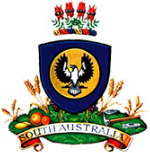
The South Australian Coat of Arms was originally granted by King Edward VIII in 1936, however the current arms was updated in 1984. The shield depicts an image of a Piping Shrike bird on a gum branch against a rising sun. Above the shield are the state colours of South Australia: red, blue and gold. Above these are four Sturt’s Desert Pea flowers. The shield rests on green grass which yields wheat, barley and grape vines. On the ground, there are citrus fruits such as oranges and lemons as well as two cog wheels and a miner’s pick. The scroll at the base of the arms reads ‘South Australia’.
Emblems
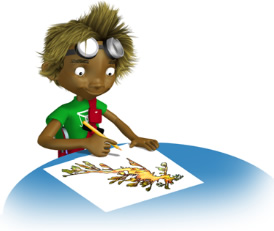
The floral emblem of South Australia has been Sturt’s Desert Pea since 1961. The plant, which is a member of the legume family, is named after Captain Charles Sturt who explored the Adelaide region in 1844.
The bird emblem for South Australia is the Piping Shrike or White Backed Magpie. The bird is said to represent resourcefulness and bravery. The animal emblem of South Australia has been the Hairy-Nosed or Plains Wombat since 1970. The marsupial’s scientific name means ‘hairy-nosed broad-fronted’.
South Australia’s marine emblem has been the Leafy Seadragon since 2001. The Leafy Seadragon uses its unusual looks to camouflage itself to look like seaweed and seagrass.
South Australia’s gemstone emblem has been opal since 1985. South Australia is home to three major opal fields: Coober Pedy, Mintabie and Andamooka.
South Australia attractions
South Australia is home to some of Australia’s most spectacular beaches, exciting destinations and remarkable sights. It holds many manmade and natural wonders, some of which are detailed below.
The Ghan Railway
The Ghan is named after the Afghan camel drivers who arrived in Australia in the 1800s. The Afghans and their camels accompanied expeditions to explore the outback and assisted transport and communication.
The first train to run along the original Ghan line, in 1929, was steam powered. It was officially called the ‘Afghan Express’. The original line followed the route of an explorer named John MacDouall Stuart from Adelaide to Alice Springs (then named Stuart).
In 1980, the old railway track, which was narrow and termite-riddled, was abandoned. In 2004, the route was extended all the way to Darwin in the Northern Territory. The train now covers 2,969 km of the scenic Australian outback.
The Murray River
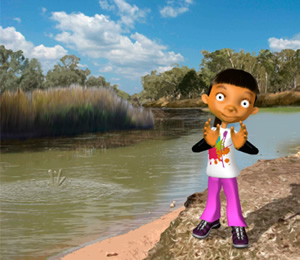
The Murray River runs through three states: New South Wales, Victoria and South Australia where it flows into the Southern Ocean.
For European settlers, the river was like a water highway with paddle steamers transporting goods such as wool and wheat up and down the Murray. Today the Murray River is a popular tourist destination. The riverbank provides great spots for camping and fishing. You can even cruise the river on a houseboat. Many water sports are enjoyed along the Murray such as water skiing and kayaking.
The Murray Basin is home to many native creatures such as Emus, Kangaroos, Parrots, Black Swans, Pelicans and Murray Cod.
The Murray is a precious resource, with the water vital to farms and native wildlife. It must be protected from threats such as salinity (rising salt levels) and overuse.
South Australia fast facts
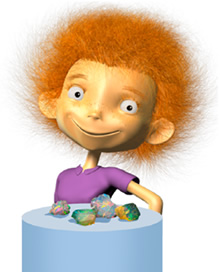
- The famous Australian cricketer, Sir Donald Bradman, lived in Adelaide with his wife and children.
- South Australia is often referred to as the ‘Festival State’ and the people that live there are sometimes known as ‘crow eaters’.
- South Australia’s Coober Pedy mine is the world’s largest producer of opals.
- Ben Murray is an interesting South Australian. He was born in 1891 to an Aboriginal mother and an Afghan father. He served in World War I at Gallipoli where he was captured as a Turkish prisoner of war. Upon his release, he returned to South Australia where he worked at many different jobs. He lived to be over 100 years old.
- The highest recorded temperature in Australia was in 1960 in Oodnadatta in South Australia, when the temperature reached 50.7°C. Now that is hot!
- Lake Eyre, in the outback of South Australia, is the largest salt lake in the world. While it does flood it is normally dry. It has been the location for many attempts at breaking the world land-speed record.
- South Australia shares borders with all of the mainland states as well as the Northern Territory.
References
The following links will direct you to the homepage of the websites used as references for this topic.
- Australian Bureau of Statistics: www.abs.gov.au
- South Australia: www.southaustralia.com
- australia.com: www.australia.com
- State Library of South Australia: www.slsa.sa.gov.au




